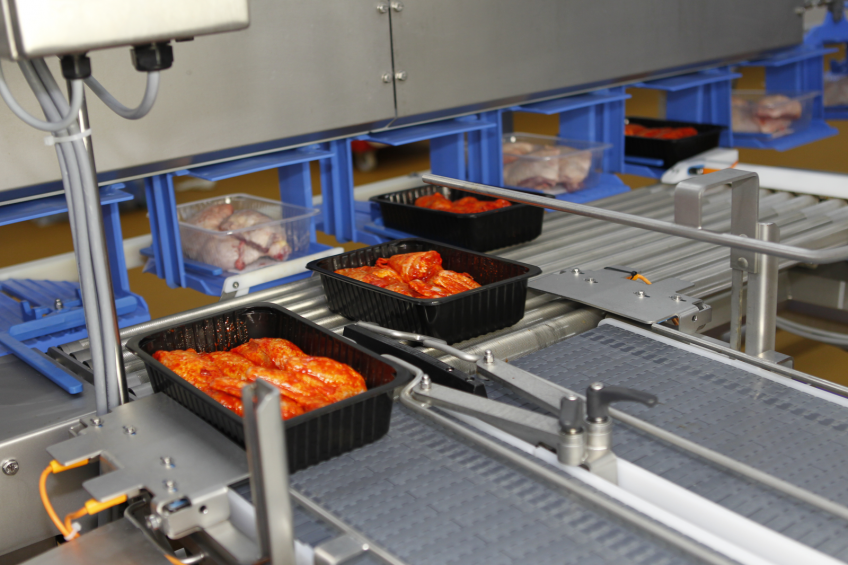Fully automatic tray handling

TrayTrack is a new development of Marel Stork Poultry Processing to improve processing logistics. It is a fully automatic system to take trays from where they are filled to a remote dedicated tray sealing/wrapping and labelling area, without taking up valuable floor space.
By Ad Bal
The TrayTrack system is flexible, using automatic buffers to match different tray sizes to multiple tray sealing/wrapping and labelling lines. It cuts costly reworking and ensures the smooth flow of the product from packing through to the chill store. The system allows all products to be tracked and traced through to the end of the packing process, whilst at the same time giving management real-time information on the efficiency of sealing/wrapping and labelling equipment.
TrayTrack is a solution in today’s large complex portion packing operations, where a product is loaded into a wide variety of trays of different materials, shapes and dimensions, where tray and label changes are frequent and where sealing/wrapping and labelling equipment downtime is unavoidable.
The system takes unsealed/unwrapped trays with poultry products from where they were loaded and distributes them intelligently over multiple sealing/wrapping and labelling lines, ensuring the smooth flow of products through the packaging department.
Overhead conveyor
A TrayTrack line consists of a Sigma overhead conveyor system with covered tray carriers at 12″ pitch. Automatic loading stations load trays with products into the carriers of the TrayTrack line, which conveys them to automatic unloading stations, from where they are transferred onto the sealing/wrapping and labelling lines. The number of loading and unloading stations depends on the number of packing – tray sealing/wrapping – and labelling lines.
TrayTrack is programmed by the plant management using a module of the Stork PDS-NT control system. This then runs the system automatically, directing the transfer of trays to the system and deciding when and where each tray is unloaded. The aim is to match the flow of trays as efficiently as possible to available sealing and labelling equipment. A line clearer and carrier washer finishes off the line, which handles up to 120 trays per minute.
Heart of the system
The TrayTrack carrier is the heart of the system and will handle trays in a wide variety of sizes. It has a sliding arm which moves in and out during loading and unloading. Movement of the arm is controlled by flippers mounted at each loading and unloading station and activated by the PDS-NT control system.
As the trays are unsealed at this point, the carrier has a cover to prevent contaminants falling onto the raw meat. After production all carriers are washed and blown dry in a carrier washer installed as the last component in the line.
Loading and unloading
A TrayTrack loading station has a buffer conveyor and loading area with rotating rollers. After filling, each tray is conveyed into the loading station’s buffer to wait for an empty TrayTrack carrier. Once the system detects an empty carrier, it moves the tray forwards onto the loading area. The station’s rotating rollers and the sliding arm on the carrier then transfer the tray onto the TrayTrack carrier. When the system gives the signal to unload a tray at a given unloading station, the sliding arm on the carrier moves forward, pushing the tray from the TrayTrack carrier onto a belt feeding a sealing/wrapping and labelling system.
Sometimes it may happen that a sealing and labelling line is not available for a tray allocated to it. In this case the tray will not be unloaded but will be buffered in TrayTrack, making one or more additional circuits until the line does become available.
Better packaging room layout
With TrayTrack, tray filling, involving the handling of raw meat, and tray sealing/wrapping and labelling can be kept entirely separate, giving the advantage of one clear central tray sealing/wrapping and labelling area. Moving products between the two areas does not take up valuable floor space as this happens on an overhead conveyor system.
Besides the possibility to programme the system and then running it automatically, PDS-NT makes full tracking and tracing possible. It also gives full information on the product handled by the system and will even record sealing and labelling equipment downtime.
[Source: World Poultry magazine Vol 29 nr 10]












